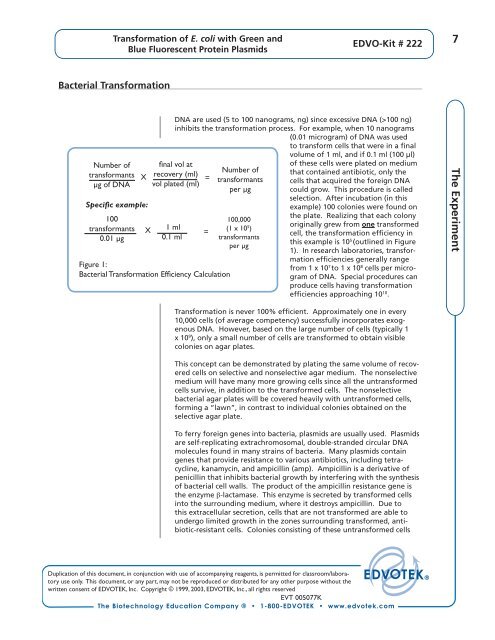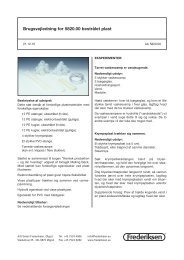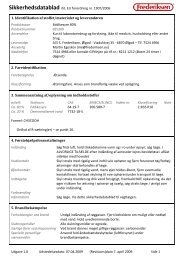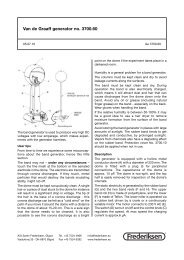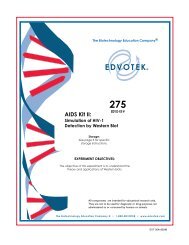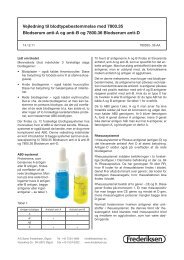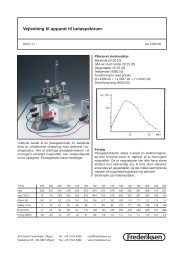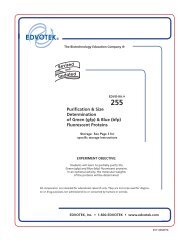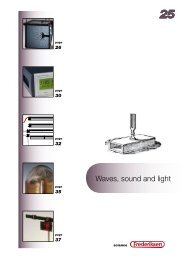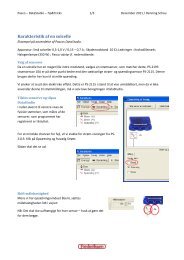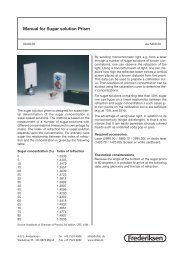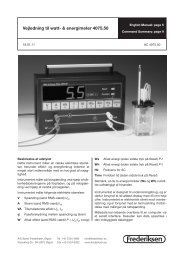Transformation of E. coli with Green and Blue ... - Frederiksen
Transformation of E. coli with Green and Blue ... - Frederiksen
Transformation of E. coli with Green and Blue ... - Frederiksen
Create successful ePaper yourself
Turn your PDF publications into a flip-book with our unique Google optimized e-Paper software.
<strong>Transformation</strong> <strong>of</strong> E. <strong>coli</strong> <strong>with</strong> <strong>Green</strong> <strong>and</strong><strong>Blue</strong> Fluorescent Protein PlasmidsEDVO-Kit # 222Bacterial <strong>Transformation</strong>Number <strong>of</strong>transformantsµg <strong>of</strong> DNA100transformants0.01 µgXSpecific example:XDNA are used (5 to 100 nanograms, ng) since excessive DNA (>100 ng)inhibits the transformation process. For example, when 10 nanograms(0.01 microgram) <strong>of</strong> DNA was usedto transform cells that were in a finalfinal vol atrecovery (ml)vol plated (ml)1 ml0.1 mlFigure 1:Bacterial <strong>Transformation</strong> Efficiency Calculation==Number <strong>of</strong>transformantsper µg100,000(1 x 10 5 )transformantsper µgvolume <strong>of</strong> 1 ml, <strong>and</strong> if 0.1 ml (100 µl)<strong>of</strong> these cells were plated on mediumthat contained antibiotic, only thecells that acquired the foreign DNAcould grow. This procedure is calledselection. After incubation (in thisexample) 100 colonies were found onthe plate. Realizing that each colonyoriginally grew from one transformedcell, the transformation efficiency inthis example is 10 5 (outlined in Figure1). In research laboratories, transformationefficiencies generally rangefrom 1 x 10 7 to 1 x 10 8 cells per microgram<strong>of</strong> DNA. Special procedures canproduce cells having transformationefficiencies approaching 10 10 .The Experiment<strong>Transformation</strong> is never 100% efficient. Approximately one in every10,000 cells (<strong>of</strong> average competency) successfully incorporates exogenousDNA. However, based on the large number <strong>of</strong> cells (typically 1x 10 9 ), only a small number <strong>of</strong> cells are transformed to obtain visiblecolonies on agar plates.This concept can be demonstrated by plating the same volume <strong>of</strong> recoveredcells on selective <strong>and</strong> nonselective agar medium. The nonselectivemedium will have many more growing cells since all the untransformedcells survive, in addition to the transformed cells. The nonselectivebacterial agar plates will be covered heavily <strong>with</strong> untransformed cells,forming a “lawn”, in contrast to individual colonies obtained on theselective agar plate.To ferry foreign genes into bacteria, plasmids are usually used. Plasmidsare self-replicating extrachromosomal, double-str<strong>and</strong>ed circular DNAmolecules found in many strains <strong>of</strong> bacteria. Many plasmids containgenes that provide resistance to various antibiotics, including tetracycline,kanamycin, <strong>and</strong> ampicillin (amp). Ampicillin is a derivative <strong>of</strong>penicillin that inhibits bacterial growth by interfering <strong>with</strong> the synthesis<strong>of</strong> bacterial cell walls. The product <strong>of</strong> the ampicillin resistance gene isthe enzyme b-lactamase. This enzyme is secreted by transformed cellsinto the surrounding medium, where it destroys ampicillin. Due tothis extracellular secretion, cells that are not transformed are able toundergo limited growth in the zones surrounding transformed, antibiotic-resistantcells. Colonies consisting <strong>of</strong> these untransformed cellsDuplication <strong>of</strong> this document, in conjunction <strong>with</strong> use <strong>of</strong> accompanying reagents, is permitted for classroom/laboratoryuse only. This document, or any part, may not be reproduced or distributed for any other purpose <strong>with</strong>out thewritten consent <strong>of</strong> EDVOTEK, Inc. Copyright © 1999, 2003, EDVOTEK, Inc., all rights reservedEVT 005077KThe Biotechnology Education Company ® • 1-800-EDVOTEK • www.edvotek.com


